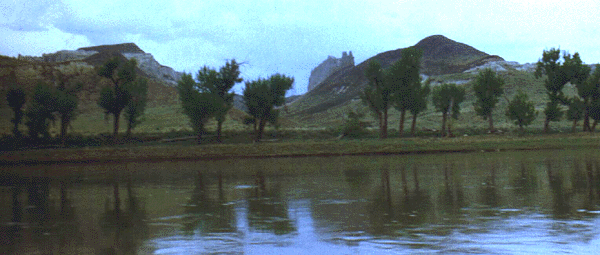From Fort Benton, Montana To The Judith River
James R. Kyle
A Voyage of 88 Miles on The Missouri River,
Traveled In The Historical Time Frame of 1808
On the morning of the eighteenth, hunters Jed Smith and Daniel Hendricks
would take the wagons to the terminus of our voyage at the mouth of the Judith river,
some eighty-eight miles down stream. The remainder of the expedition, Captain
Michael McMillan, camp-cook, Gerald Fahrenthold, the Reverend John Brooks and
myself, cooks helper and camp-guard, would loiter about the settlement till Jed and Dan'l
returned in the afternoon of that day. We visited the places that had interest, and met
some people that would help us to locate certain points of interest of our
trip. Two of the men broke off from the others to frequent the local drinking
establishments to have a last quaff of ale and ardent spirits. However, in their quest the
two had succumb to the usual effects of over indulgence, and our Captain was set to find
and recover them. He succeeded in finding them, in a most merry and lively condition
three establishments down the pike. After trying, without much success, to pry them
from the dram shop, he told them of a place of much interest to the reason of what and
why they came to this place. They all the made a hasty exit for the place of his
suggestion, only to be laid into the bed of a wagon and hauled back to the place of where
the boats would be launched on the morrow. One of the hunters, Jed Smith, of the
expedition, took charge of the more intoxicated fellow and together they spent the night
under the large bateau.
In the morning all of the men changed into their proper attire for the business of
placing the canoe and bateau down the River Missouri, and loaded the boats. A rather
small gathering of the local inhabitance had gathered to see the expedition off from their
port, and with a salute from the two pound swivel gun on the bow of the bateaux, we
were off down the river. Captain McMillan took his place at the stern of the bateau,
next I on the rear set of oars, then Gerald Fahrenthold on the amidship oars, and on the
bow looking out for river hazards, was our good Reverend John Brooks. It was he who
was the reason for this voyage of river navigation, being a student of the sciences wishing
to make a study of the fauna, flora, geological formations, and a Calvinist to bring the
Word of God to the wild Indians of the plains.
When we did locate a suitable encampment, one that provided good wood and flat
surface on which to sleep comfortable, all hands knew just what to do. Past practice with
the same men under the command of any commander is easy and efficient when all know
their station and position in the structure of a good camp. The procedure is attacked in
this order:
There is a tradition among the river men of the Missouri, one that has gone on
through time. That being, when a man, for the first time, is to pass the Platte river, he
shall enter the above section in the state of a "clean shaven face". It is for that reason
of which I have taken my razor and joined into that proud rank and file, as this is my
first voyage above the Platte river and here I am above the Platte a considerable
distance. This point of river navigation is ½ mile above Crow Coulee Bar on the south
bank of the river. The expedition has come about 31 miles from our disembarkation.
The weather is cool, overcasting skies look as to rain. However, it is difficult to
determine to what could occur, as the temperature is falling as the sun is setting, and it
is known to snow and hail in these regions at this time of the year. The wind is picking
up, and out of the east. I, being from the lower section of this river, feel a bit uneasy
about this. In the lower Missouri valley this means very ill weather, not conducive for
traveling; either by land or river.
It was soon after supper that all the men settled down to their respective bedrolls
and fell into a restful sleep, I being the new-comer to this certain geographical location,
was hard pressed to fall into a state of sleep -- but soon did. Until soon after 2:00 a.m.,
or there about, I was awoken by the wind. The estimate force of over thirty miles per
hour winds came in waves of gusts and had untied the tie-downs that held fast our
overhead canvas. There was no rain assorted with this wind, as yet anyway, but the force
was that of unnerving, and I was once again hard pressed to fall asleep.
In the morning, to get the fire going, I was compelled to dig a rather deep hole to
shelter the embers from the wind, so as to not let the heat run sideways and effectively
bring the pot to a boil. At this time of year there is a good amount of dry long blade
grasses in and around the encampment, so starting the fire was of little concern. What
was the concern was the containment of a small fire as not to let it get out of control and
set the surrounding prairie ablaze. I was continually compelled to stop from my duties
and stomp the blaze in order to gain control. All hands are well as we begin our decent
into the "White Cliffs" area.
We loaded each of the craft, and proceeded on a downward course of the river in
an easternly direction. The river bends most frequently but the main course is set to the
east. Going about five miles we took note of the old Lewis and Clark encampment on
the north side of the river. Here the Corps of Discovery camped the night of May 31,
1805 and Morning of June 1st.
In the journals Lewis writes of the days activities:
Passing the "Coal Banks" he again writes:
The wind on the section of the river became very strong, causing the canoe, and
the bateaux to drift sideways to the current. It is with difficulty that we can maintain
the course and to fight the wind is becoming rather a chore. With only seven miles from
when we started, we are compelled to put to shore and discuss the possibility of making
encampment and wait out the wind, or for the night. We talked to a native of the area
that said that when the wind is from the east, as it is today, it will die off and rain will
come. After the rain, the sky will clear and be calm. I can see in the western horizon
dark clouds, as the temperature is dropping. We have decided to set camp for the night,
and make supper, early. All hands join in for the unloading of the bateaux and the large
canoe -- and once again the procedure is followed as explained earlier. Our encampment
is two miles up stream from the "Coal Banks". The native suggests that we replenish our
fresh water supply at his location, for it is much better than farther down. He provides
us a ferry across to his "camp".
After a supper of stew of vegetables, hardtack, sausage and buffalo tongue, we
secure the canvas for a night of wind and rain. The nights have been very bright as in
comparative to that of the lower elevations, as of what I am accustom to.
In the morning we took stock of what occurred the night before. It had rained
about 1 ½ inches and Dan'l received a good part of the wind and cold. We prepared our
breakfast of salt pork and hardtack, as the canvas and some of the bedrolls dry in the
sun. The native was correct in the weather, as the wind died off the rain came, and
today it is a good clear day. We how load the boats and proceed down the river, to a
north course for about 3 miles to the "Coal Banks".
We find a most suitable encampment a little under 17 miles from where we spent
last night in the wind and rain. It is here where Captains Lewis and Clark spent the
night of May 30th and morning of the 31st, 1805; in the journals Lewis writes:
((Lewis writes about today's Kipp Rapids JK)) "the banks and sides of the bluff were more steep than usual and were now
rendered so slippery by the large rain that the men could scarcely walk...." He than goes
on to state that they had past several encampments of Indians, 100 strong, along the
north bank. Although the banks have been stripped of all wood for as far as one and two
miles back from the rivers edge for the fuel for the steamboats, Lewis reports that there
are a few scattered groves of cottonwood here and there. And states that they are
encamped at a small grove of cottonwood where we are now encamped, just opposite
"LaBarge Rock". ((This prominent landmark is named for the most famous river pilot and captain of
the history of steam boating on the Missouri river, and the founder of the town of Fort Benton, Montana.,
Captain Joseph M. LaBarge -- my wife's great-great-grandfather. JK))
This is a lovely encampment. I made many "sketches" of the area where we are
camped, and found it very peaceful. I do suppose that it is a favorite among the travelers
of this river, as there are many other campsites along the shore on this, the north side.
In the afternoon, all the members of the expedition took a walk up Eagle creek, just to
the west of where we were encamped, to locate Native American pictographs. After a
time of about one hour we were successful in locating one. The depiction was that of an
Indian on a horse carrying a lance, inscribed into the stone wall. We could tell that it
was an original one as the weathering was complete and undisturbed. There was also a
date of unclear notation.
After we got back he said that he wanted to lay down and rest, perhaps he would
feel better after a while. I wrote in my journal and decided that I would have a look
around on top of the high hills that were to the north, just above our encampment.
Once there I found the remainder of our party busy in digging out an ant hill, finding
some seed beads. They all pointed out to me that where we were standing was an old
encampment of over 30 lodges of the Blackfeet Indians -- all along the hill to the east
from where I was standing. This evidence was in the form of "lodge rings", 12 to 16 foot
diameter circles of rocks, open on the east side, that were moved to provide a even and
comfortable floor. The ant hill, which we were dismantling, was almost in the middle of
one. I could almost feel the presence of those people, looking over the edge at the Corps
of Discovery coming up river in 1805 to set camp at the river's edge at Eagle creek, or the
name that Lewis gave to it, "Stone Wall Creek". It was here that Lewis and Clark, as
well as the other men who could write, gave the most poetic lines of the voyage.
All hands were up at about ten o'clock a.m. Except for Dan'l, who said that he
preferred to spend time in his bedrolls. I started coffee, and Gerald prepared some fired
salt-pork. We all took a late breakfast. All hands scattered their bedrolls out in the
breeze and some intermit sunlight to dry the light moisture from the cloth.
We all spent the day re-sighting our firelocks and cleaning them. Some of the
men partook in a little target practice. I was very content to do absolutely nothing,
enjoying the day walking the shore and observing the sight of the large dark rock just
across the river from our encampment. I walked back to camp and washed two of my
shirts that so needed it. All hands retired to the bed-rolls early, and soon fell into a good
sleep. I have taken to an illness, and have a tight feeling in my chest. I fear that I have
succumb to the dreaded "river fever".
In the morning everyone, except I, being late in rising and let the Captain make
his own coffee. The smell of fried bacon, saltpork and boiled coffee drifted to my nostrils
and I had to get up. The two smells that cause one to arise from the warmth of the bed-rolls was in the air, and nothing, but nothing, could keep me from the cook fire. After
getting a few sticks of fire wood, I joined my comrades in arms around the fire.
After about one hour of just sitting there, we all set about with the business of
loading the bateau and canoe. Dan'l too has a cold, even though he is much worse than
I, I felt as a bad cold was invading my inner-self, so I knew that Dan'l was not at all
feeling better than I. After loading the boats, and resumed our downward progression
of travel. With the good Reverend Brooks at the stern oars and I on the amidship set,
Jed Smith on the stern guiding us to where we would leave the river for the wagon that
was placed there some five days ago.
Passing the Lewis and Clark encampment of May 30, 1805 on the north shore
and on to Pablo Island. Pablo Rapids, 1 ½ miles down, is perhaps the most narrow of the
river thus far, and the roughest, but not to disrupt the craft that we have or that of the
canoe, and we proceeded on.
Three and one half miles down from Pablo Rapids, on the south shore, is
Slaughter River and just up stream on the north is the encampment for Clark and Lewis
for May 29, 1805 and again on June 29, 1806 -- when they were on the way down the
Missouri toward home. On the way up on the evening of May 29, Lewis writes:
We did not stop here, but pressed on as it was raining, to get to the takeout port
of the Judith river landing. However I shall return to step ashore here and make
"sketches" and notes of what I view. For it was here that a buffalo came charging through
the Corps of Discovery's encampment on the early morning of May 29,
1805.
As Captain Lewis relates in his journal:
((One can tell by the exceptionally long run-on sentence, that Lewis was truly excited and wanted to get
this incident down as quickly as possible. JK))
This voyage was taken and completed in the historical time frame of 1808.
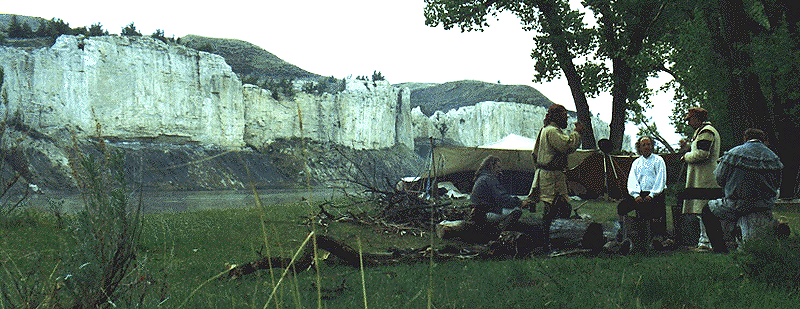
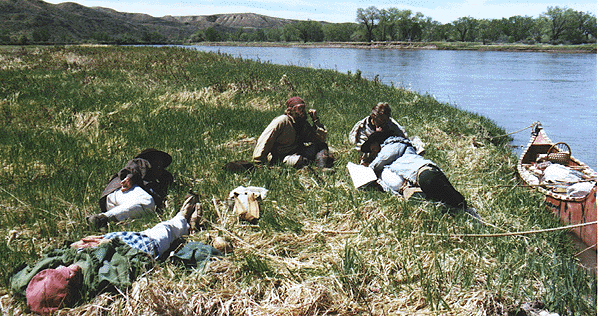
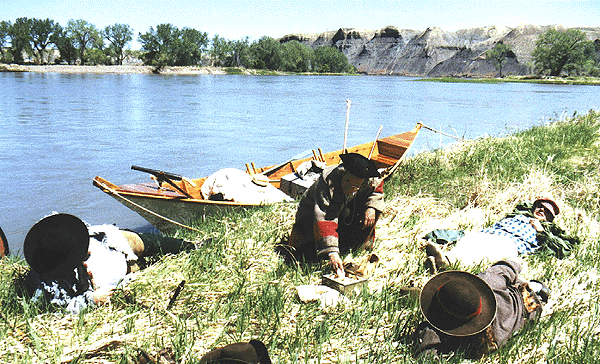
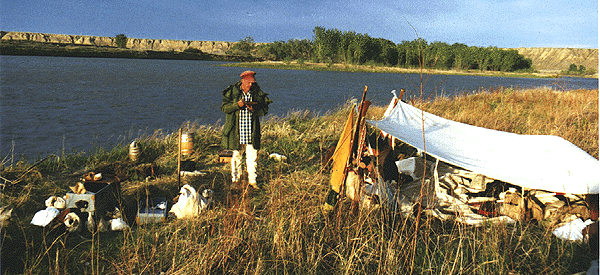
"Capt. C. Walked on shore this morning but found it so excessively bad that he shortly
returned......"
"The hills and river clefts which we passed today exhibit a most romantic appearance. The bluffs of the river rise to the hight of from 2 to 300 feet and in most places nearly
perpendicular......"
"The stone of which these walls are
formed is black, dense and durable, and appears to be composed of a large portion of
earth intermixed or cemented with a small quantity of sand and a considerable portion
of chalk or quarts....."
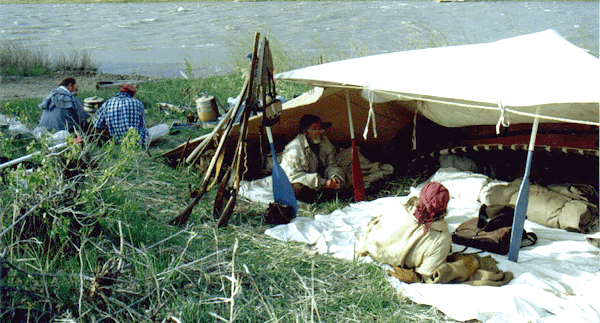
"this day we proceeded with more labor and difficulty than we have yet
experienced; in addition to the imbarrasments of the rappid courant, riffles, and rockey
point[s] which were as bad if not worse than yesterday,"
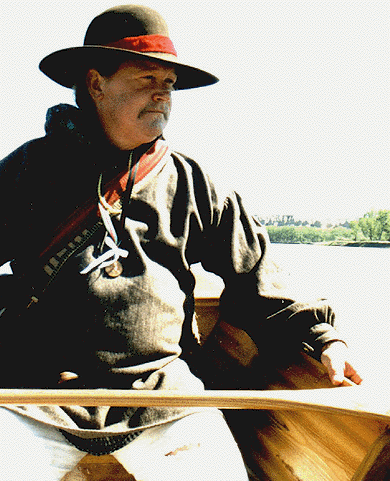
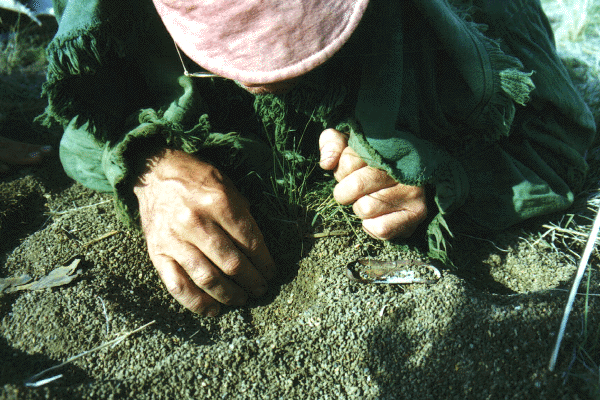
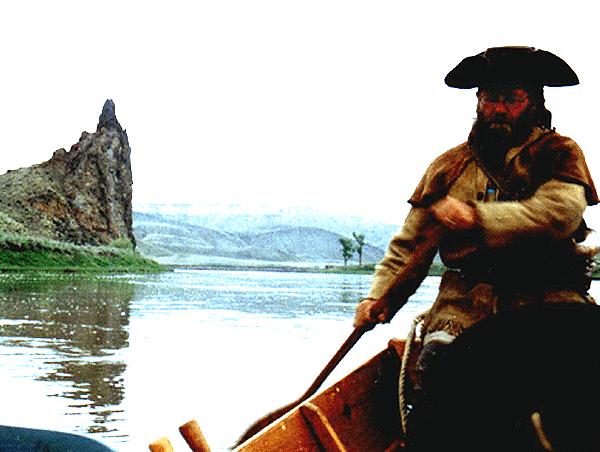
".....today we passed on the Star. Side the remains of a vast many mangled
carcasses of Buffalow which had been driven over a precipice of 120 feet by the Indians
and perished; the water appeared to have washed away a part of this immense pile of
slaughter and still their remained the fragments of at least a hundred carcases they
created a most horrid stench....."
Then goes on to say:
.... we came too for dinner opposite the entrance of a bold river 40 yrds. Wide which falls in on the Larb. Side this stream we called Slaughter
river."
((Today visitors will see that the river is called, Arrow creek JK))
Last night we were all allarmed by a Large buffaloe Bull, which swam over from
the opposite shore and coming along side the white perogue, climbed over it to land, he
then allarmed ran up the bank in full speed directly towards the fires, and was within
18 inches of the heads of some of the men who lay sleeping before the centinel could allarm
